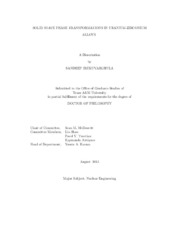| dc.description.abstract | Uranium-10wt% zirconium (U-10Zr) alloy nuclear fuels have been used for decades and new variations are under consideration ranging from U-5Zr to U-50Zr. As a precursor to understanding the fission gas behavior in U-Zr alloys using ion implantation, a basic study on the U-Zr metallurgy was completed using EPMA, DSC, XRD, Optical microscopy, and TEM with a focus on solid state phase transformations in alloys containing 2, 5, 10, 20, 30, and 50wt% zirconium. Alloys were cast by crucible melting using high temperature furnace under argon atmosphere in yttrium oxide crucibles and various thermal profiles were used to study phase transformations in these alloys.
Using TEM, XRD, and DSC data, it was ascertained that athermal-ω, along with martensitic α1, formed in all alloys quenched from γ phase. XRD could detect the presence of athermal-ω only in U-20, 30 and 50wt%Zr alloys. BSE images for as-cast alloys of 2, 5, 10, 20, and 30wt%Zr had lamellar microstructure with lamellae rich in zirconium. All alloy samples clearly showed a heating transformation pertaining to δ → γ in DSC data while XRD could only confirm the presence of δ phase in U-20, 30, and 50wt%Zr alloys. An explanation is offered for the absence of δ phase peaks in uranium-rich alloys based on its formation mechanism.
Alloy samples of U-2, 5, and 10wt%Zr were step-cooled from γ phase by annealing in the (α + δ) phase field before cooling to room temperature revealed broad peaks for δ phase indicating incomplete collapse of {111}γ planes. Both as cast and γ- quenched alloys were annealed at 600degreeC, in the (α + δ) phase field for 1, 3, 7, and 30 days. Microstructures of the samples in both cases contained uranium-rich matrix and zirconium-rich precipitates and WDS analyses were consistent with their being α-U and δ phase respectively. However, XRD data for annealed alloys never showed peaks for δ phase even though it’s area fraction was within the detection limits.
Moreover, the peaks which were present in U-20wt%Zr vanished after annealing for 7 days. Based on the data obtained, it is suggested that it is more appropriate to consider the presence of metastable diffusional-ω instead of a stable δ in the as-cast alloys and that it is not stable at 600degreeC. | en |


